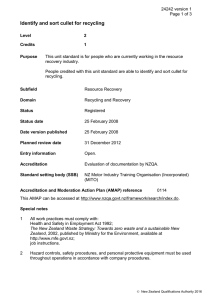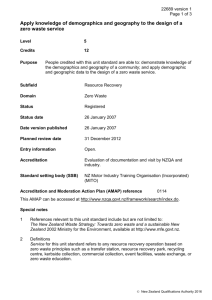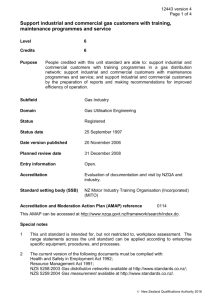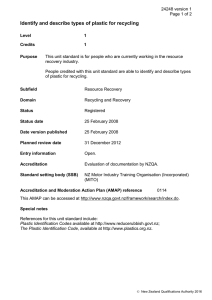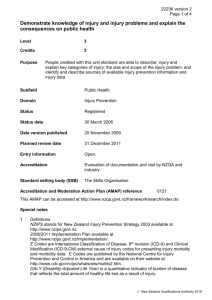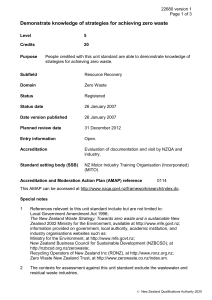24249 Sort plastics for recycling at a resource recovery facility
advertisement
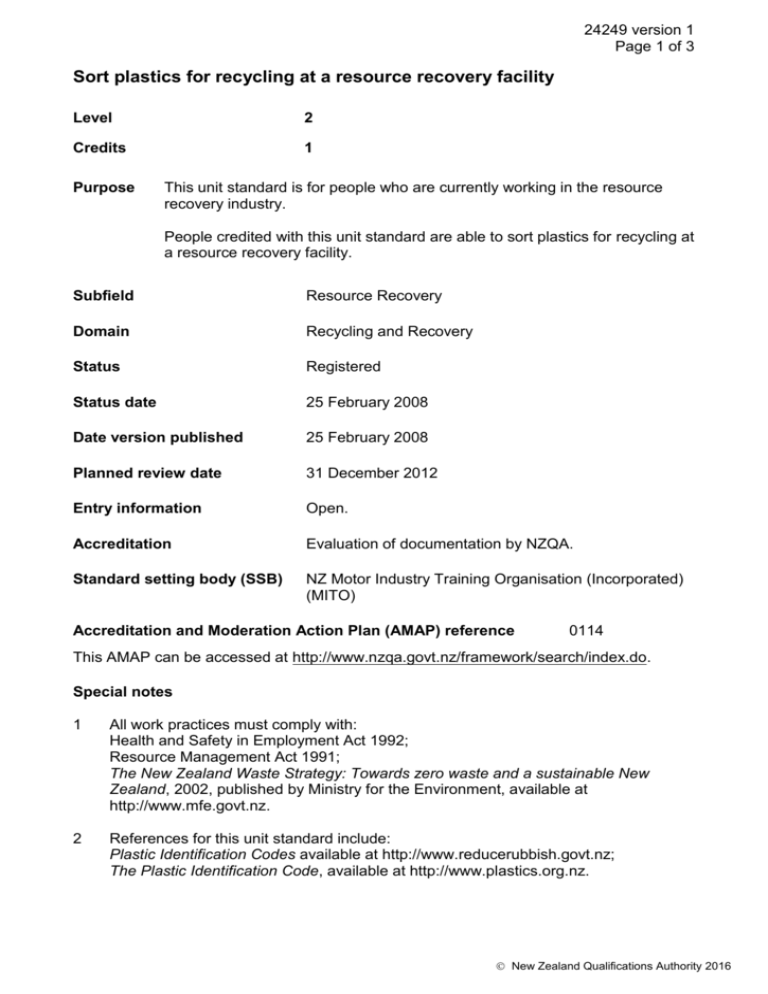
24249 version 1 Page 1 of 3 Sort plastics for recycling at a resource recovery facility Level 2 Credits 1 Purpose This unit standard is for people who are currently working in the resource recovery industry. People credited with this unit standard are able to sort plastics for recycling at a resource recovery facility. Subfield Resource Recovery Domain Recycling and Recovery Status Registered Status date 25 February 2008 Date version published 25 February 2008 Planned review date 31 December 2012 Entry information Open. Accreditation Evaluation of documentation by NZQA. Standard setting body (SSB) NZ Motor Industry Training Organisation (Incorporated) (MITO) Accreditation and Moderation Action Plan (AMAP) reference 0114 This AMAP can be accessed at http://www.nzqa.govt.nz/framework/search/index.do. Special notes 1 All work practices must comply with: Health and Safety in Employment Act 1992; Resource Management Act 1991; The New Zealand Waste Strategy: Towards zero waste and a sustainable New Zealand, 2002, published by Ministry for the Environment, available at http://www.mfe.govt.nz. 2 References for this unit standard include: Plastic Identification Codes available at http://www.reducerubbish.govt.nz; The Plastic Identification Code, available at http://www.plastics.org.nz. New Zealand Qualifications Authority 2016 24249 version 1 Page 2 of 3 3 Hazard controls, safety procedures, and personal protective equipment must be used throughout operations in accordance with company procedures. 4 Definitions Company procedures means the documented methods for performing work activities and includes health and safety, environmental, and quality management requirements. They may refer to manuals, codes of practice, or policy statements. Resource recovery facility refers to a facility that receives materials from the waste stream for resource recovery, treatment, or disposal. Terms used to describe such facilities include transfer station and recycling centre. Elements and performance criteria Element 1 Sort plastics for recycling at a resource recovery facility. Performance criteria 1.1 Job requirements are confirmed in accordance with company procedures. 1.2 Hazards of working with plastic and plastic sorting equipment are identified, assessed, and controlled in accordance with company procedures and legislation. Range 1.3 equipment may include conveyor belt; control includes but is not limited to – personal protective equipment. Types of plastic are identified and sorted in accordance with company procedures and job instructions. Range types – as listed in a plastics identification code; sorting may be for transport or processing depending on the workplace; evidence is required of sorting at least three types. Please note Providers must be accredited by NZQA, or an inter-institutional body with delegated authority for quality assurance, before they can report credits from assessment against unit standards or deliver courses of study leading to that assessment. Industry Training Organisations must be accredited by NZQA before they can register credits from assessment against unit standards. Accredited providers and Industry Training Organisations assessing against unit standards must engage with the moderation system that applies to those standards. New Zealand Qualifications Authority 2016 24249 version 1 Page 3 of 3 Accreditation requirements and an outline of the moderation system that applies to this standard are outlined in the Accreditation and Moderation Action Plan (AMAP). The AMAP also includes useful information about special requirements for organisations wishing to develop education and training programmes, such as minimum qualifications for tutors and assessors, and special resource requirements. Comments on this unit standard Please contact the NZ Motor Industry Training Organisation (Incorporated) (MITO) info@mito.org.nz if you wish to suggest changes to the content of this unit standard. New Zealand Qualifications Authority 2016
